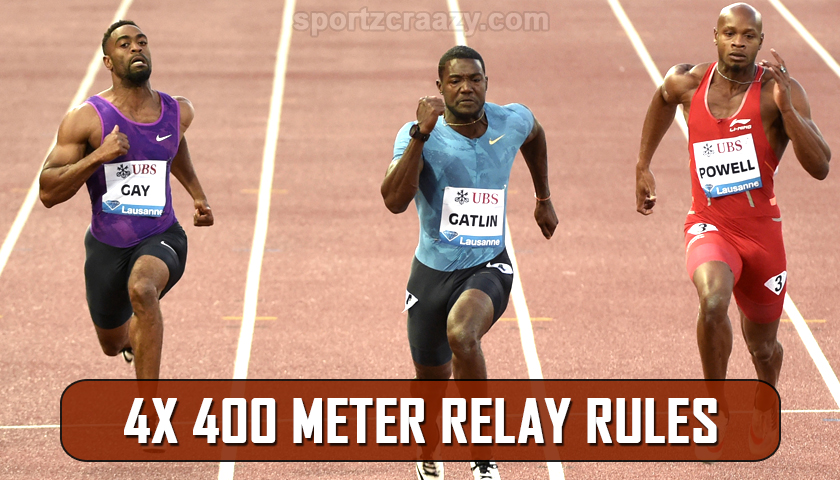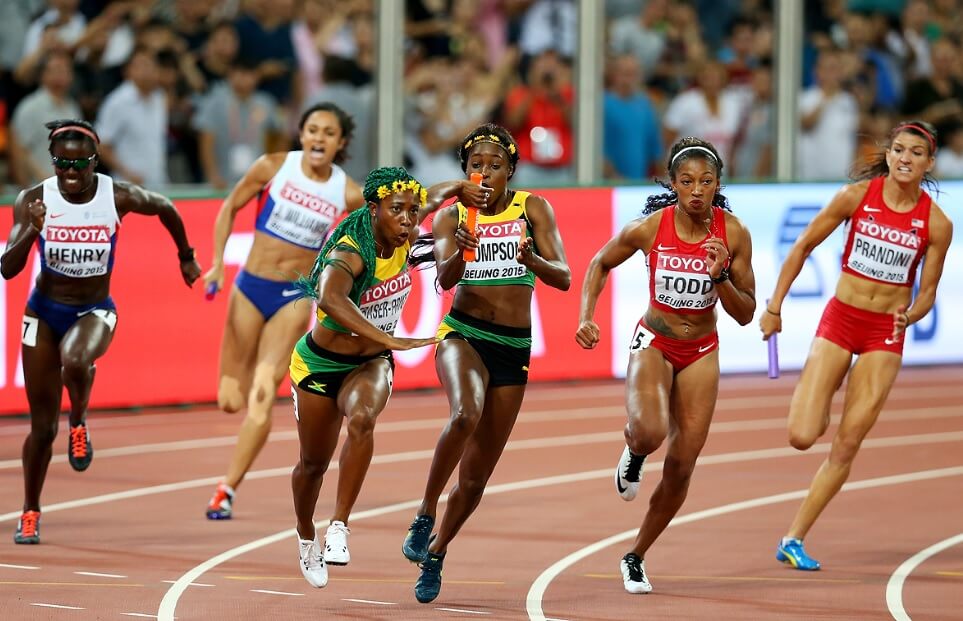The 4 x 400 metres relay is often called as the 1600 m relay. The 4 x 400 metres relay is played with four runners in each participating team. Each player has to run 400 metres holding a baton in his hand. When one runner passes the baton to another runner, then another runner starts to run to reach the next player.
A relay team should have enough speed to finish a race on time besides this there are many other factors which are important for a relay team too, they should have coordination among them, and they should have the ability to pass the baton to each other without disturbing the speed. While only passing the baton is not only the rule there are many different rules for a team during the relay which they should follow. The rules for the relay for both male and female teams are the same.
Passing the Baton | 4 x 400 Metres Relay
During the relay, it’s very important the athletes have the knowledge on about how to pass a baton to another teammate. It is vital for them because if they do not pass the baton without following the rules his/her team will get disqualified.
- The participants should exchange the baton within the exchange zone, and the baton must be carried with bare bands throughout the race.
- Passers should remain in their lanes after passing the batons so that other runners may not find difficulty.
- The baton should not be dropped during the race or while passing the baton which would result in disqualification of the team.
- The baton is exchanged in two methods Over-hand and under-hand.
- The baton should be held in his/her right hand while running.
As soon as the receiver athlete receives the baton and starts running, he/she cannot see behind the passer runner in order to specific techniques.
The passing zones for the second and last passing of baton are marked 10m either side of the start/finish line.
| Also Read: Curling Rules, Introduction & How to Play |
The Incoming runner: The duty of the runner coming towards the end of phase 1 is to have proper control over his mechanical energy as the lousy control in mechanical energy may lead to the difficult handoff of the baton, which may influence the team to lose the race.
The Outgoing runner: Outgoing runner is one who receives the baton and then starts running. The foremost duty of the outgoing runner is to be in a position in which he/she can easily hold a baton and could take a good run-off. The leg should face towards the track while stretching their hand backward to hold a baton and easily run.
The Third Leg: The third runner is also known as an essential leg as it has the last chance to get some space between his/her competitors before the final pass. Some of the teams keep their fastest runner at the third leg to take the lead in the end, and some of them keep their slowest runner in the end so that the first two may take the lead.
The Fourth Leg: The fourth runner is also often known as the “Anchor.” He is the one who ends up the race at last. The primary motive of the last runner is to be calm, patient and not to mess up with anybody during the race.
Strategies For 4 x 400 Metres Relay
- Choosing the orders of the runners: All the teammates with the help of their coach should decide that which runner has to be in which leg. As planning will increase their chances of winning the race. They should arrange themselves in a manner that they could have a smooth handoff which may save their time, and they may take the lead.
- Regular Practice: As everyone knows that practice makes a man perfect so by practicing regularly for the race the runners may improve their coordination ability and may find simple ways on how to pass the baton, take a turn, and lower the speed at the end and how to walk in their lane to prevent from disqualifying.
- Running the race: In this a person should have a proper field just like professional for training by which they may know the techniques on how to pairing, taking turns effectively. Practice the baton exchange technique effectively so that at the time of race runners may not face any difficulty in passing the baton efficiently and quickly.
- Double Training: double up your training for better coordination ability and to increase your endurance and lessen your fatigue.
- Take proper diet: Proper diet is the essential element of the strategies for the races as if a person will have enough nutritious and healthful food he/she may be able to practice more effectively and for a more extended period. An athlete should be wise enough in choosing his/her meal for their body development.
- Meditation: An athlete should everyday meditate for 25-30 minutes to increase his/her concentration power. More the concentration power more the training will happen effectively. Meditation helps a lot to athletes as it helps them to come over their anxiety during their competitions. If they will be calm during their match, they will be able to perform more effectively and may have chances of winning the race.
- Doing Yoga: While performing yoga asanas an athlete makes his/her body healthy. As yoga makes the muscle of a person healthy and makes a person flexible which is beneficial for athletes during their race. Yoga helps them to be away from different diseases which would affect their health as well as their performances.
4 x 400 Metres Relay Rules
- The baton can only be passed within the exchange zone, which is 20 meters long. Exchanges made outside the zone—based on the position of the baton, not the runners’ feet—result in disqualification. Passers must remain in their lanes after the pass to avoid blocking other runners.
- The baton must be carried by hand. If it is dropped, the runner can leave the lane to retrieve the baton as long as the recovery doesn’t lessen his or her total running distance. Runners may not wear gloves or place substances on their hands to obtain a better grip on the baton.
- Any athlete entered in the relay race may compete on a country’s relay team. However, once a relay team begins the competition, only two additional athletes may be used as substitutes in later heats or the final. For practical purposes, then, a relay team includes a maximum of six runners—the four who run in the first heat and a maximum of two substitutes.
| Also Read List of 7 Go-Karting in Bangalore You Should Visit |
4 x 400 Metres Relay: The information provided above is for the person who participates in races and relays. Here are some of the strategies and rules for relays which one should follow during his/her race and the strategies provided above will help a person to make his/her performance more effective and powerful than others. Anything did with the help of strategies, and full knowledge leads to success. Yoga and meditation are good for a common person too.









